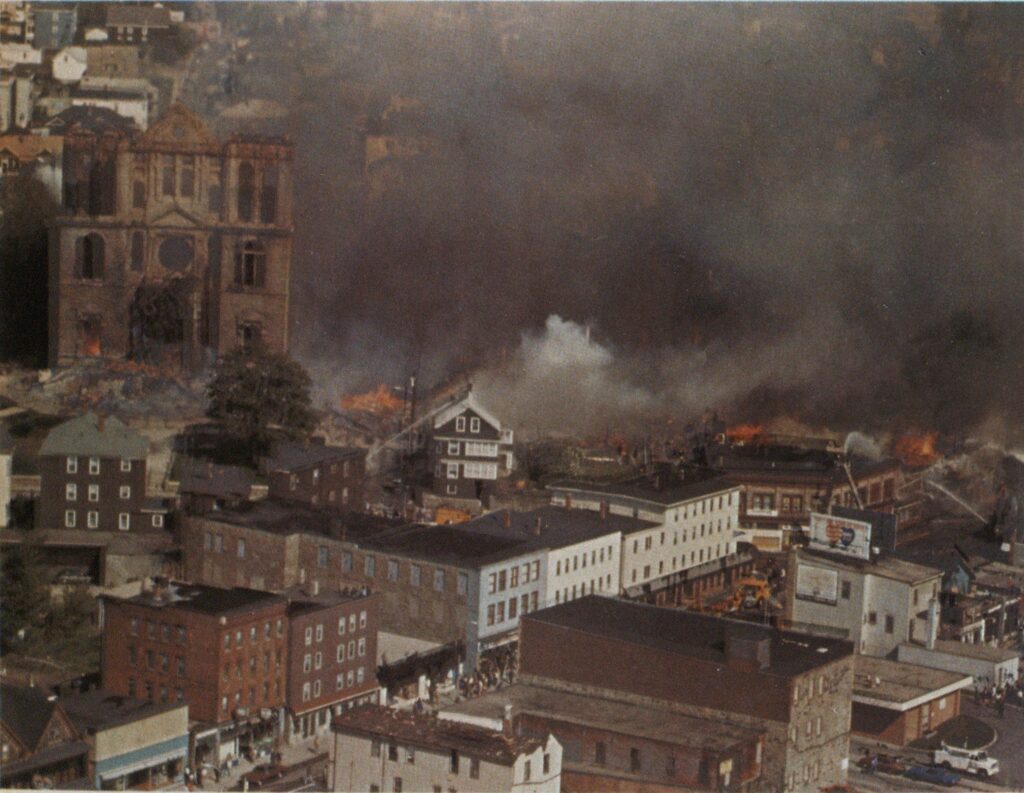
Delayed Alarm at Church Fire Leads to $13 Million Conflagration
features

New Bedford Standard-Times photo by Hank Seaman
Workmen soldering gutters during restoration of an 86-year-old church in Fall River, Mass., are believed to have started a $13 million conflagration that left perhaps 300 persons homeless.
Fire fighters from 38 communities battled the blaze, first in the Notre Dame de Lourdes church with its 235foot twin spires and then as it spread to 33 other buildings. Some homes in the area are only 2 or 3 feet apart.
The workmen tried to use portable extinguishers when the fire was first discovered, according to newspaper reports, but thick smoke prevented them from entering the area. By the time the Fall River Fire Department received the alarm at 2:25 p.m., May 11, and arrived at 2:27, smoke was also thick in the street. Neighbors later reported seeing smoke as early as 2:00. It is assumed that the fire had been burning for up to an hour before being discovered.
Fire Chief Louis Shea, Jr., listened to the report of the First-in company and immediately ordered a second alarm before responding himself. When he saw the massive cloud of smoke from headquarters, Shea called for a third alarm. Within four minutes after the first alarm, Shea had committed seven of eight engine companies and three of four ladder companies.
Initial attack
The initial attack involved a 2 1/2-inch line to the interior of the church This proved largely ineffective, however, and flames began to curl from the entire perimeter of the 90 by 75-foot ceiling. Realizing that a collapse of the loft was imminent, the interior attack was abandoned. Immediately upon retreat, the upper windows began to blow out and within seconds, due to the increased flow of oxygen to and the rapid spread of the fire, the ceiling collapsed.
The church was of a Romanesque Corinthian design. There were no columns inside the church. A massive lattice of 2X2-foot dry-cut beams provided support for the roof and loft. The spires were constructed of wood and covered with copper sheathing.
Fire fighters’ efforts were redirected to containment rather than extinguishment. A 20 to 25-mph wind blowing from the northeast, coupled with a fire load that Shea later suggested would fill three to four lumberyards, created such intense radiant heat that not only did fire apparatus begin to scorch, but fire fighters’ protective clothing as well.
Mutual-aid call
As first-in apparatus were repositioned, radiant heat rapidly ignited nearly all of the buildings on Bedard St. and several immediately beyond. A general alarm was sounded, calling back a full shift and putting an elaborate mutual-aid effort into effect.
Shea, realizing the potential of the now out-of-control fire, conceded the church and row of burning houses as lost. To the north of the church was a convent housing 56 retired nuns. Immediately east of the church was the rectory and brothers’ home. Shea ensured that apparatus was available to protect these should the wind shift.
The suppression strategy became to enter the backyards of Bedard St. and confront fire with hand lines. With Fall River apparatus falling back and attempting to confine the perimeter of the fire, this method of attack was left to mutual-aid companies. However, a delay in their reaching the fireground, as well as the existence and threat of simultaneous fires forced this idea to be abandoned. At that moment, fire alarm headquarters was reporting a fire on the roof of the five-story Howard Arthur mill a half-mile away and that there was no apparatus to respond.
Assistance diverted
Shea instructed fire alarm to order the first two en route mutual-aid companies to that fire. This increased delay gave the main fire headway to the north side of Pleasant St. Flaming brands from these fires were also carried to the south side of Pleasant St., where they ignited three more buildings. As mutual-aid companies began to arrive, Shea assigned them to these fires.
Meanwhile, other companies were setting up a firebreak on the north side of Pleasant St. This effort included a Fall River and out-of-town ladder companies, hand lines and master stream appliances. The severe demand for water prompted Shea to request the water department to boost pressure in the area. He also requested the Freetown Fire Department to respond and augment the water supply with their 4-inch hose from an adjacent hydrant grid.
Staging area
The chief of neighboring Somerset was in charge of a staging area on Eastern Ave. As out-of-town apparatus arrived, he deployed them to a particular location. In all, 25 cities and towns in Massachusetts and 13 in Rhode Island provided mutual aid with fire fighters and approximately 43 engines, 13 ladders and 15 lighting units. Of these about 33 engines, eight ladders and nine lighting units operated at, or in the immediate area of the fire.
With the mutual-aid assistance, the perimeter held. By 6:10 p.m., the fire was declared to be contained and under control. Apparatus remained on the scene through the next day, wetting down the smoldering remains.
Four main factors contributed to the successful control of this conflagration, given the delayed alarm and geographical conditions:
- The availability and response of planned mutual-aid apparatus.
- Good fire tactics and management decisions, including setting up perimeters, setting up a staging area, delegating responsibility for particular areas to other officers, and recognizing key structures and taking a stand at them.
- An adequate water supply.
- A quick and orderly evacuation of threatened residents.
As Shea commented following the fire, “It was only because we had anticipated a fire of this magnitude that we were able to confront it as we did. No chief should be so naive as to think it can’t happen to him. It can and it will. It’s just a matter of time and the right conditions.”

Photo by David Souza


